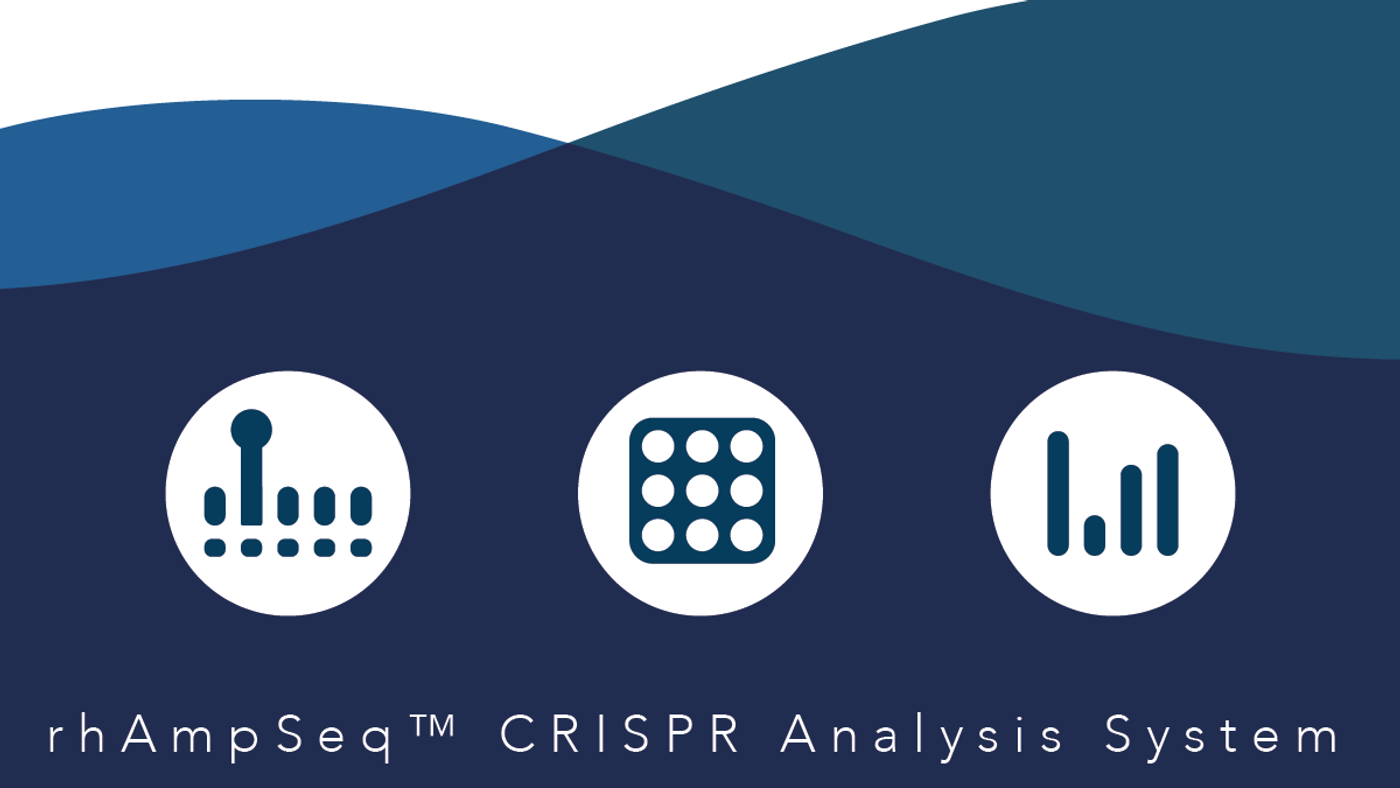The rhAmpSeq™ CRISPR Analysis System for next-generation sequencing analysis of CRISPR edits
CRISPR genome editing generates double-stranded breaks (DSBs) in genomic DNA and is a targeted method by which to achieve gene knockouts and knock-ins. Endogenous repair of DSBs results in an array of possible outcomes including insertions, deletions, and substitutions. Regions of the genome that have sufficient homology to the delivered guide RNA (gRNA) may also be cleaved, resulting in potential off-target genomic edits. Next-generation sequencing (NGS) via amplicon enrichment is one method of quantifying both on- and off-target edits. Deep sequencing across the target region (on-target) and potential off-target genomic loci is essential to understand the outcome of genome editing experiments with regards to quantifying efficiency and specificity.
Amplicon sequencing is a targeted NGS method that uses PCR to create sequences of DNA called amplicons. For amplicon sequencing, IDT has developed the rhAmpSeq system, which allows precise PCR amplification, generating highly multiplexed libraries ready for amplicon sequencing on Illumina NGS platforms. The rhAmpSeq system is based on our proprietary RNase H2-dependent PCR (rhAmp™ PCR) technology that easily facilitates panel design and uses a high-throughput workflow to generate NGS-ready amplicon libraries for deep, targeted sequencing.
Here, we present the rhAmpSeq CRISPR Analysis System, an end-to-end solution enabling primer design, amplicon library generation, and NGS analysis of single or multiplex CRISPR on- and off-target editing data (Figure 1). The rhAmpSeq CRISPR Analysis Tool provides an intuitive graphical interface to analyze, explore, and generate publication-ready reports without the need for advanced bioinformatics skills. Some advantages of the rhAmpSeq CRISPR Analysis System are:
- Capture diverse allelic events with optimized primer design for single or multiplex amplification
- Perform only two PCR amplification steps in a fast, easy workflow
- Achieve cost-effective library preparation using custom panels combining on- and off-target potential editing sites into pooled amplification reactions
- Reduce the formation of primer-dimers or misprimed PCR products
- Obtain an accurate, publication-ready, CRISPR NGS editing report using the fully compatible rhAmpSeq CRISPR Analysis Tool.
Figure 1. Overview of CRISPR editing analysis workflow.
CRISPR editing
The first step in a CRISPR editing analysis workflow is the CRISPR editing (Figure 1). For CRISPR editing, the Alt-R CRISPR system of design tools, Cas nucleases, guide RNAs, and other relevant reagents will provide all the necessary components to edit your target sites. For more information, see The CRISPR basics handbook.
Off-target nomination
Since the rhAmpSeq CRISPR Analysis System provides a targeted sequencing method, it first requires identification of potential targets, or off-target nomination (Figure 1). On-target sequences are the sequences that are targeted for CRISPR editing, so these sequences are known, but off-target sequences must be nominated using either empirical methods (e.g., GUIDE-seq [1], CIRCLE-seq [2], Digenome-seq [3], DISCOVER-seq [4], or other empirical methods) or in silico tools (e.g., IDT CRISPR-Cas9 guide RNA design checker) that attempt to identify off-target, double-stranded breaks that may occur in the genome.
Off-target quantification: rhAmpSeq CRISPR Panel design
After the on- and off-target sites are nominated, the rhAmpSeq Design Tool designs the rhAmpSeq CRISPR Panels (Figure 1). A rhAmpSeq CRISPR Panel is a collection of rhAmpSeq CRISPR assays; each of these assays consists of one forward and one reverse rhAmp Primer designed to amplify a specific DNA region. The rhAmpSeq Design Tool aims to maximize PCR target specificity at intended loci and minimize any amplification of unintended loci that might consume valuable sequencing reads.
Target confirmation and publication
The PCR products from the rhAmpSeq PCR reactions are run on an Illumina NGS instrument and sequenced. The rhAmpSeq CRISPR Analysis Tool analyzes the raw sequencing data and confirms editing of the targeted site along with a publication-ready report of off-target edits.
References
- Tsai SQ, Zheng Z, et al. (2015) GUIDE-seq enables genome-wide profiling of off-target cleavage by CRISPR-Cas nucleases. Nat Biotechnol 33(2):187-197.
- Tsai SQ, Nguyen NT, et al. (2017) CIRCLE-seq: a highly sensitive in vitro screen for genome-wide CRISPR-Cas9 nuclease off-targets. Nat Methods 14(6):607-614.
- Kim D, Bae S, et al. (2015) Digenome-seq: genome-wide profiling of CRISPR-Cas9 off-target effects in human cells. Nat Methods 12(3):237-243.
- Wienert B, Wyman SK, et al. (2019) Unbiased detection of CRISPR off-targets in vivo using DISCOVER-Seq. Science 364(6437):286-289.
- Kurgan G, Turk R, et al. (2021) CRISPAltRations: a validated cloud-based approach for interrogation of double-strand break repair mediated by CRISPR genome editing. Mol Ther Methods Clin Dev. 2 (21) 478-491
For research use only. Unless otherwise agreed to in writing, IDT does not intend these products to be used in clinical applications and does not warrant their fitness or suitability for any clinical diagnostic use. Purchaser is solely responsible for all decisions regarding the use of these products and any associated regulatory or legal obligations.












